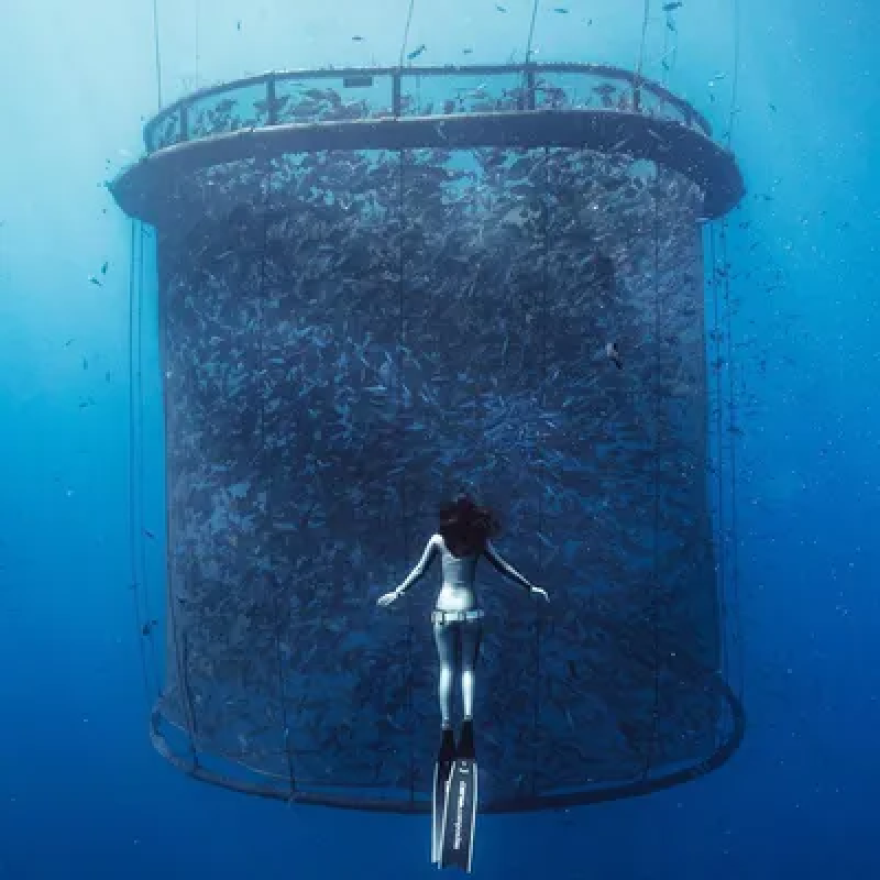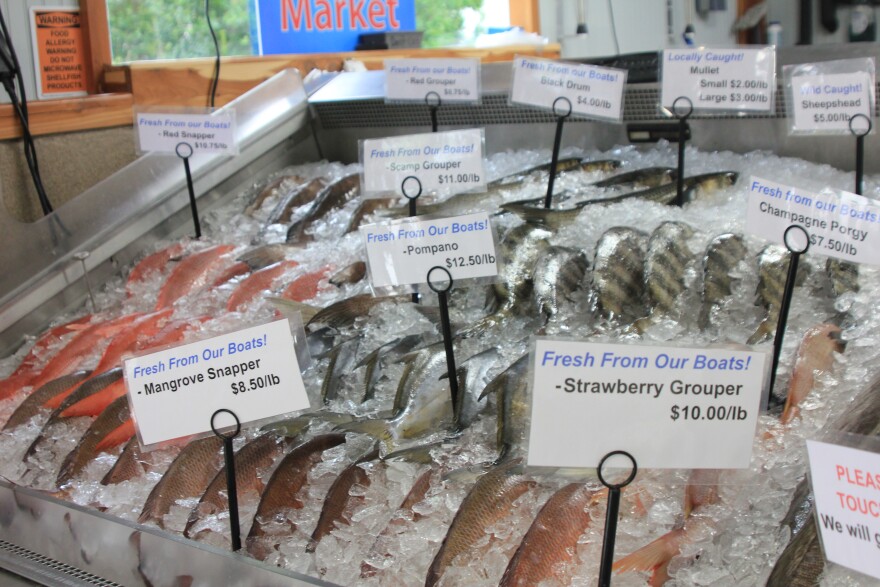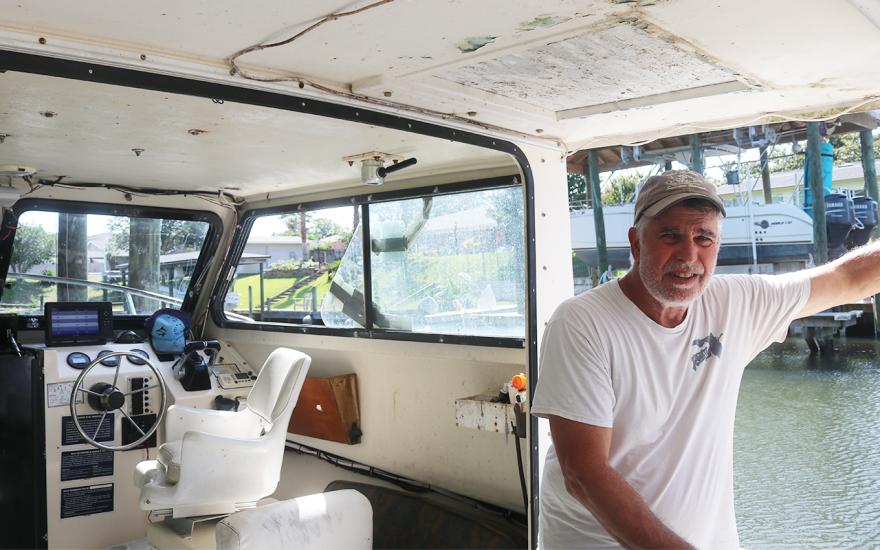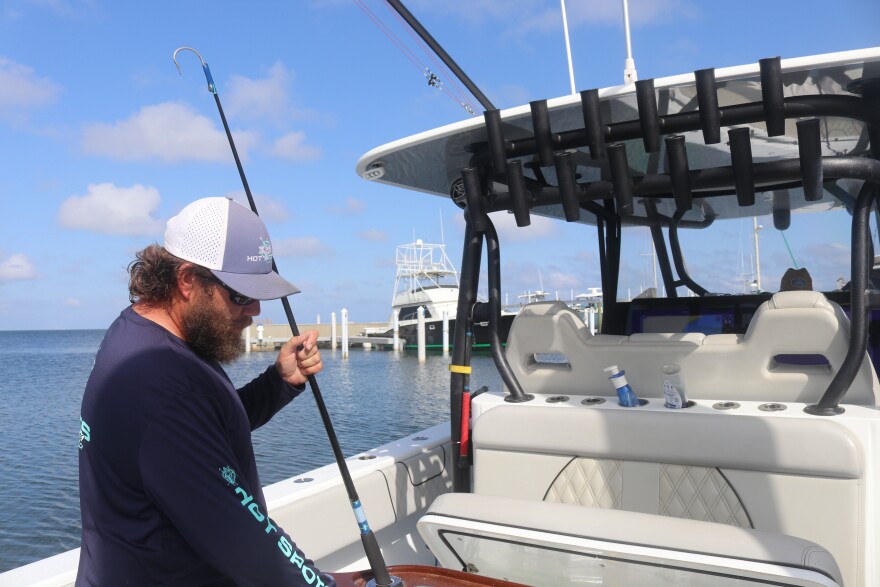Correction appended: This story was updated to remove the "offshore" description of a salmon farm in Washington state.
Neil Sims has a vision. He imagines thousands of red drum fish swimming in the open Gulf, the Florida sun glinting off coppery scales. These red drum are farmed, not wild. They circle inside a cylindrical floating cage miles offshore, harvested for America’s seafood market.
Sims is the founder and CEO of Ocean Era, a marine research and development company that’s been trying to launch a pilot finfish farm in Gulf waters for close to seven years. The test project would raise roughly 20,000 red drum fish in a single underwater net pen about 45 miles southwest of Sarasota, with the eventual goal of scaling up to commercial size. Commercial farms might have about a dozen of the floating pens.
“From an environmental perspective, we need people to be eating more seafood, because it is very, very low impact,” Sims said. “And offshore aquaculture has shown this is the way that we can do it with minimal impact on water quality, ocean bottom, coastlines. So we feel a moral obligation to be moving this.”
As the global population continues to rise and wild-caught fisheries are pushed to the brink of collapse, over half the seafood eaten by people is now farmed. Total U.S. aquaculture sales in 2023 reached over $1.96 billion, up 3.8% from 2018, according to the most recent census.

Red drum are currently farmed in Florida, but only on land. Thousands of on- or near-shore aquaculture sites in the Gulf raise everything from cheap catfish and shellfish to high-dollar salmon and pompano. Florida is one of the largest aquaculture producers, second only to Louisiana. But so far, aquaculturists haven’t been approved to farm any of these species in the open ocean.
Sims sees the Gulf as a prime spot to keep aquaculture on an upward trend, and he’s not the only one. Private companies have begun eyeing the Gulf for commercial fish farms, and President Donald Trump’s administration is working to identify areas where open-ocean aquaculture could thrive.
Trump’s been a fish farm fan since his first administration, when he directed NOAA Fisheries to identify “aquaculture opportunity areas” in federal waters. But offshore aquaculture progress stagnated under President Joe Biden. Now, the industry is seeing new interest since Trump returned to the White House. In April, he signed an executive order directing the Secretary of Commerce to cut down on “regulations that overly burden America’s commercial fishing, aquaculture, and fish processing industries.”
Yet despite years of work, millions of dollars spent and support from the federal government, the first offshore fish farm has yet to be built in the Gulf of Mexico. Under an administration focused on slashing regulations, that could change. But environmentalists, marine scientists and Gulf locals fear open-ocean aquaculture could further damage an already polluted Gulf and take over fishermen’s territory.
A sea of opportunity
Expanding the reach of American goods while spurning imports from foreign nations has become a hallmark of the second Trump era, and seafood is no exception. Following directions from a 2020 Trump executive order, NOAA Fisheries highlighted three aquaculture opportunity areas off the coast of Texas in a September environmental impact statement. The opportunity areas would be capable of holding three to five commercial-scale aquaculture farms, spanning between 500 and 2,000 acres of the Gulf.
The agency also considered three sites in Florida and two in Louisiana— but ultimately decided not to include them in the final draft. Florida was omitted due to the state’s close proximity to military activity.
“That doesn’t mean that aquaculture can’t happen off the coast of Florida,” said Andrew Richard, the agency’s southeast aquaculture coordinator.
The NOAA analysis provides a baseline for commercial aquaculture companies to tee off farm proposals, Richard said. The agency shoulders the weight of the initial permitting, streamlining a famously difficult process.
Environmental regulations cause yearslong delays and bureaucratic migraines for hopeful aquaculturists, who can’t so much as dip a toe in the Gulf before slogging through a mass of permits. If it seems expensive, it is — a major deterrent for the industry.
“Folks who are looking to establish a farm are really struggling because it is almost impossible to get through the regulatory process,” said Drue Banta Winters, the campaign manager for Stronger America Through Seafood, an aquaculture advocacy group.
Aquaculture proponents like Winters argue open-ocean fish farms provide an efficient and sustainable solution to America’s seafood deficit. Roughly 80% of the seafood Americans consume is imported from other countries, with U.S. seafood imports towering over exports by more than $20 billion.
The federal government and aquaculture supporters cite America’s reliance on foreign seafood as a case for putting fish farms in the Gulf. Open-ocean aquaculture would invigorate coastal economies, Winters said, especially those that rely on seasonal commercial fishing.
But denting the seafood deficit would take a lot of farms — and they’d need to go big. Building and maintaining an industrial aquaculture facility is a multi-million dollar endeavor, which means farms must scale up if they want to stay afloat.

The Gulf is already a heavily industrialized sea: It’s dominated by oil rigs, dotted with military testing sites and criss-crossed by cruise ships, fishing boats and shipping tankers. Protected from near-shore oil rigs, Florida is a place of respite for humans and marine species alike. But all that could be put at risk by the first fish farm, said Christian Wagley, a coordinator with the environmental nonprofit Healthy Gulf.
“There’s never going to be one fish farm,” he said, “any more than there was ever going to be one oil rig in the Gulf of Mexico.”
Will it hurt the environment?
In Sarasota, environmentalists and locals have spent years trying to block the Ocean Era pilot project from setting up shop in their saltwater backyard.
Their main concern is the poop. The Environmental Protection Agency issued a permit to Ocean Era in May, allowing the Sarasota project to produce up to 55,000 pounds of waste — mostly uneaten food, dead fish and feces — every year.
EPA’s permit is the final step in a multi-year process, though Ocean Era still has to clear a host of legal challenges.
Fish excrement is high in nutrients like phosphorus and nitrogen, which can create blooms of algae and oxygen-deprived swaths of ocean. Those same nutrients are implicated in bouts of noxious red tide on Florida’s Gulf Coast and the infamous Gulf Dead Zone, an ecologically starved area near the mouth of the Mississippi River.
Red tide, which poisons schools of fish and stinks up beaches, unfurls between 11 and 46 miles offshore. A fish farm, even a small one, inside this range could worsen the effects of the blooms, said Abbey Tyrna, the executive director of the Sarasota-area environmental group Suncoast Waterkeeper.
An open-ocean aquaculture facility could also threaten native species, according to Tyrna.
Especially in larger farms, net pens often keep a high density of fish in close quarters, allowing disease or parasites like sea lice to spread rapidly and infect wild fish. Endangered species like sea turtles, dolphins and whales can also become entangled in a farm’s equipment.
“We don’t have anything to gain in Sarasota County,” Tyrna said. “We only have everything to lose.”

The Suncoast Waterkeeper and a coalition of other environmental groups petitioned the EPA in June, arguing the agency didn’t adequately consider how Ocean Era’s operation would impact the environment.
Sims maintains that open-ocean aquaculture will have a negligible impact on the environment, and that his company’s project is still just a pilot. The project could be ready to go in a matter of months, Sims said. But if legal challenges keep cropping up, it could be years.
He wants locals to bring a mask and snorkel out to the pen — then if the Sarasota community really decides Ocean Era isn’t wanted, the company will take its project somewhere else.
“This was where fish were meant to be farmed,” Sims said. “All of this hand-wringing and fear mongering about potential environmental impacts is just…anti-aquaculture activist groups that are trying to foment this fear in people, and the reality of it is vastly different.”
Experts say it’s possible for open-ocean aquaculture to be done sustainably — but it’s complicated. For the ocean to dilute pollution, a facility has to be sited at a certain depth, over a sandy bottom, in specific currents. Fish can be packed at a lower density to reduce disease, and netting can be improved to prevent escapes. Yet siting a farm improperly could have serious impacts.
Thousands of farmed fish escape every year from storm-damaged or poorly maintained pens in Norway, the world’s largest salmon producer. Scientists have found that escapees breed with wild fish, increasing the spread of disease and changing the genetic makeup of wild populations.
If Ocean Era is committed to preserving the environment, one net pen isn’t likely to harm the Gulf, said Rod Fujita, a marine ecologist at the University of California Santa Cruz.
“The big question is, what happens after that?” Fujita said. “Will all the other companies that follow, once they see the profit, have similar dedication to environmental protection? I doubt it.”
Making a farm environmentally safe adds more costs to an already expensive process. If companies aren’t required to follow environmental regulations, few will, Fujita said — which is why those requirements exist in the first place.
With the Trump administration’s interest in offshore aquaculture, he said, there’s a risk of weakening the guardrails on an industry that isn’t ready for uncontrolled growth.
It’s possible to streamline the process without compromising the Gulf, he said, but cutting too many corners could allow companies to bypass regulations that protect the environment and human safety. Without careful permitting, Fujita added, too many farms could be allowed to claim their piece of the sea before experts are sure of the effects.
And in the Gulf, where monstrous storms roar through nearly every year, an open-ocean farm could become hurricane bait.
Ocean Era’s cages are designed to avoid storm damage. The company uses a submersible net pen design which allows a cage to bob beneath the surface during a hurricane, similar to how a swimmer can dive underneath a strong wave.
While those pens could work in theory, they’ve never been tested in the Gulf.
“You can do the best you can engineering these pens to be bulletproof, but the ocean is really, really, really powerful and unpredictable,” Fujita said.

The only way to find out is through a test run — but that comes with risks. If a commercial-scale aquaculture facility in the Gulf was damaged or destroyed by a hurricane, it could release thousands of farmed fish into the sea.
“The risks of raising fish offshore are enormous unless you have systems that are capable of sustaining such storms, and those systems are expensive to acquire and to maintain and to deploy,” said Daniel Benetti, the director of aquaculture at the University of Miami.
Benetti has spent his career trying to develop open-ocean aquaculture, and has worked alongside Ocean Era. It’s possible for net pens to be designed to withstand a hurricane, Benetti said, but those models are costly and difficult to operate.
Aquaculture advocates have proposed farming only species that are native to the Gulf, like red drum and striped bass. A few escapees likely wouldn’t cause a problem, but a mass jailbreak could have major impacts.
Washington state is still dealing with the fallout of a 2017 salmon farm breach that sent a quarter million non-native salmon into Puget Sound. The massive escape, caused by improper maintenance, poses serious threats to native Chinook salmon and could degrade environments and livelihoods, according to environmentalists and the local Lummi Nation. Earlier this year, the state banned commercial net-pen aquaculture, partially due to the salmon disaster.
The environmental impacts of an open-ocean farm would be nonexistent if properly sited, Benetti said, but a farm is unlikely to be successful unless a large, well-financed corporation is willing to get on board.
“It is not the technological, the environmental or even the legal challenges, which are enormous, but it is the economical viability that is the greatest challenge,” he said.
Coexisting with commercial fishers
When commercial fisherman Mark Tryon learned about plans to put a fish farm offshore of his Pensacola home, he tried to figure out more details. He asked his fishing buddies — but they knew nothing about it. The guys at the tackle shop were clueless too.
The more Tryon learned about the project, the more he soured on the idea. He felt the proposed farm, which would span just under 400 acres and intersect with Tryon’s normal fishing grounds, lacked transparency. Sitting in a plastic lawn chair next to his backyard canal, Tryon said commercial fishermen lack a strong advocate when it comes to open-ocean aquaculture.

“I can still change my mind,” he said. “But I don’t like the way the whole thing has gone down so far. Seems almost underhanded, where nobody knows anything.”

Manna Fish Farms, a New York-based company, hopes to launch submersible net pens of red drum and striped bass about 25 miles offshore of Pensacola. They’ll start small with two net pens totaling 300,000 fish, before scaling up to three million fish by year five of operation.
The goal is to start floating pens in the Gulf by 2028, Manna founder and CEO Donna Lanzetta said, though the company has fallen into regulatory quicksand as thick as Ocean Era’s. Lanzetta hopes that Congress will soon pass legislation to smooth the permitting process — lawmakers from both sides of the aisle have attempted for years to advance bills promoting offshore aquaculture, with little success.
Bipartisan senators introduced a bill called the “Marine Aquaculture Research for America,” (MARA) Act of 2025” in July. The legislation would remove regulatory barriers for open-ocean aquaculture, though the bill is still pending and has seen pushback from environmental groups.
“It’s difficult right now, because there is no clear path,” Lanzetta said. “Without the legislation, it’s difficult to raise money or even plan a business when you don’t know what your timelines are.”
Manna’s project is designed with the environment in mind, according to Lanzetta. The company plans to stock below its allowed maximum to reduce pollution, she said, and has chosen a site that doesn’t heavily interfere with shrimping or endangered species.
Manna has already talked with fishermen about the project and plans to do so in the future, Lanzetta said. If the EPA approves Manna’s permit, the agency will be required to field public comments, and Lanzetta said more public meetings will be held. Aquaculture will invigorate working waterfronts, she added, and doesn’t pose a risk to commercial fishing interests.
Commercial fishermen couldn’t harvest red drum even if they wanted to. Regulators banned non-recreational harvesting in the late 80’s after a Gulf-wide craze for Cajun-style red drum led to mass overfishing, decimating the species.

Some fishermen, like charter captain Tyler Massey, say they’re fine with Manna moving in — as long as it doesn’t interfere with their livelihoods. The new fish farm, which will span just under 400 acres, will be in Massey’s normal fishing range. Fishers can stomach one farm, but they worry Manna’s project will open the door for more.
“If they restrict a thousand-acre area that we can’t go in, that’s gonna be a problem,” Massey said, washing his Hot Spots Charters boat at a Gulf Breeze marina. “We’re already kind of limited as far as our range.”
Eric Brazer, the deputy director of the Gulf of America Reef Fish Shareholders’ Alliance, said he’s heard opposition from some fishermen, and that there needs to be more engagement with the industry.
However, he believes open-ocean aquaculture can coexist with commercial fishing. Gulf aquaculture projects have shown commitment to raising different fish than the species fishermen target — as long as that remains the case, Brazer said, the two industries can coexist.
His message?
“Proceed with caution.”



